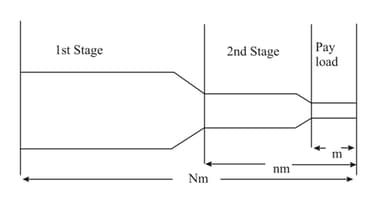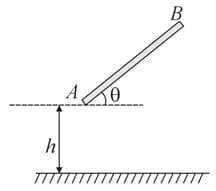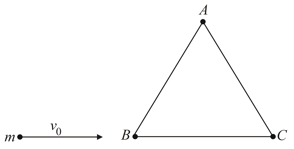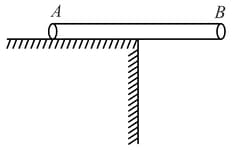A neutron is scattered through ( deviation from its original direction) degree in an elastic collision with an initially stationary deuteron. If the neutron loses of its initial to the deuteron then find the value of (In atomic mass unit, the mass of a neutron is and mass of a deuteron is ).
Important Questions on Centre of Mass, Momentum and Collisions
This problem is designed to illustrate the advantage that can be obtained by the use of multiple-staged instead of single-staged rockets as launching vehicles. Suppose that the payload (e.g., a space capsule) has mass and is mounted on a two-stage rocket (see figure). The total mass (both rockets fully fuelled, plus the payload) is

The mass of the second-stage rocket plus the payload, after first-stage burnout and separation, is . In each stage the ratio of container mass to initial mass (container plus fuel) is and the exhaust speed is constant relative to the engine. Note that at the end of each state when the fuel is completely exhausted, the container drops off immediately without affecting the velocity of rocket. Ignore gravity.
Obtain the velocity of the rocket gained from the first-stage burn, starting from rest in terms of
Obtain a corresponding expression for the additional velocity gained from the second stage burn.
Adding, you have the payload velocity in terms of Taking and as constants, find the value of for which is a maximum. For this maximum condition obtain
Find an expression for the payload velocity of a single-stage rocket with the same values of
Suppose that it is desired to obtain a payload velocity of using rockets which and . Using the maximum condition of part obtain the value of if the job is to be done with a two-stage rocket.
The block is moving to the right with a speed of when it is acted upon by the forces and . These forces vary in the manner shown in the graph. Find the velocity (in ) of the block at . Neglect friction and masses of the pulleys and cords.

A uniform rod of length is released from rest with inclined at angle with horizontal. It collides elastically with smooth horizontal surface after falling through a height . What is the height upto which the centre of mass of the rod rebounds after impact?

Three particles of mass each are joined to each other by massless rigid rods to form an equilateral triangle of side . Another particle of mass hits with a velocity directed along as shown. The colliding particle stops immediately after impact.

(a) Calculate the time required by the triangle to complete half revolution in its subsequent motion.
(b) What is the net displacement of point during this time interval?
A drinking straw of mass is placed on a smooth table orthogonally to the edge such that half of it extends beyond the table. A fly of mass lands on the end of the straw and walks along the straw until it reaches the end. It does not tip even when another fly gently lands on the top of the first one. Find the largest mass that the second fly can have. (Neglect the friction between straw and table).

Two blocks of masses and are connected by a massless elastic spring and are at rest on a smooth horizontal surface with the spring at its natural length. A horizontal force of constant magnitude is applied to the block for a certain time in which suffers a displacement and . Kinetic energy of the system with respect to centre of mass is force is then withdrawn.

(a) Calculate
(b) Calculate the speed and the kinetic energy of the centre of mass after the force is withdrawn.
(c) Calculate the energy stored in the system
